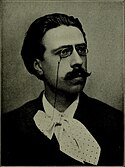Paul Gilson
| Paul Gilson | |
|---|---|
| Personlig information | |
| Født | 15. juni 1865 Bruxelles, Belgien |
| Død | 3. april 1942 (76 år) Bruxelles, Belgien |
| Uddannelse og virke | |
| Uddannelsessted | Det Kongelige Konservatorium i Bruxelles |
| Beskæftigelse | Musikolog, universitetslærer, komponist, pianist |
| Arbejdsgiver | Koninklijk Conservatorium Antwerpen, Det Kongelige Konservatorium i Bruxelles |
| Elever | André Collin |
| Kendte værker | Le Rétour au Pays |
| Genre | Klassisk musik |
| Information med symbolet | |
Paul Gilson (født 15. juni 1865 i Bryssel , Belgien, død 3. april 1942) var en belgisk komponist.
Gilson var inspireret af Richard Wagner og den russiske skole af Nikolaj Rimskij-Korsakov, César Cui og Aleksandr Glazunov, og komponerede i en konservativ, romantisk stil.
Han har mest skrevet for symfoniorkester og blæserensembler.
Udvalgte værker
- Le Rétour au Pays: Prière avant le départ - Tableau Maritime, Grande Fantaisie Descriptive (1885)
- Rhapsodie alla Marcia – for strygeorkester (1890)
- La mer – fire symfoniske sketser for symfoniorkester (1892) eller messingblæsere (1925)
- Melodies Ecossaises – for strygeorkester (1892-1893)
- Alvar – for orkester (1900)
- Ouverture Symphonique #1 (1900), #2 (1903) og #3 (1904)
- Altsaxofonkoncert #1 (1902) og #2 (1902)
- Variation Symphonique – for messingblæsere (1903)
- Binché – for messingblæsere (1906)
Kilde
| Spire |
|
Medier brugt på denne side
Forfatter/Opretter: User:Ysangkok, Licens: CC BY-SA 3.0
Start of Unfinished Symphony by Franz Schubert
Forfatter/Opretter: Internet Archive Book Images, Licens: No restrictions
Paul Gilson
Identifier: moderncomposerso00elso (find matches)
Title: Modern composers of Europe : being an account of the most recent musical progress in the various European nations, with some notes on their history, and critical and biographical sketches of the contemporary musical leaders in each country
Year: 1905 (1900s)
Authors: Elson, Arthur, 1873-1940
Subjects: Composers
Publisher: Boston : L.C. Page
Contributing Library: Harold B. Lee Library
Digitizing Sponsor: Brigham Young University
View Book Page: Book Viewer
About This Book: Catalog Entry
View All Images: All Images From Book
Click here to view book online to see this illustration in context in a browseable online version of this book.
Text Appearing Before Image:
tasie on the melodies of Canada, anotheron those of Ireland, half a dozen suites, the sym-phonic sketches entitled La Mer, the Bucolics,after Virgil, three scherzi, a festival march, a fan-fare march, and many shorter pieces. His choralworks include an Inaugural Cantata, a cantata forthe fiftieth anniversary of the Belgian telegraph,the oratorio Moses, the dramatic oratorio Francesca da Rimini, and several sets of acapella works. He has also made some interestingexcursions into the field of declamation with or-chestra, such as Le Feu du Ciel (Hugo),Christine (Leconte de Lisle), and the Japanesefable Satsuki. His operas include Les PauvresGens, Frinses Zonnenschijn, Les A ventu-rers, and Le Demon, as well as incidentalmusic to the dramas Alvar and Liefdeblaem.Of these many works the one best known inAmerica is La Mer, which has been given sev-eral times in symphony concerts. It was suggestedby a poem of Ed. Levis, which is frequently readbefore the performance. The first movement gives
Text Appearing After Image:
PAUL GILSON. THE NETHERLANDS 189 an excellent picture of sunrise at sea, with all themany-coloured splendours of the dawn. Then fol-lows some rollicking sailors music, in which theirlively songs and dances are suggested with dueanimation. The third movement portrays a love-scene between the sailor and his sweetheart, idyllicat first, but ending in sadness as he must embarkand she gives way to fear of the treacherous ocean.The finale depicts the tempest, and the sailorschoruses are introduced in mocking irony as theship goes down. Through it all runs a vein ofpoetic fancy, exquisitely suggesting the beauty andmystery of the sea. Francesca da Rimini is another powerfulwork. It opens in the realm of shades, where theguilty lovers find themselves after death. They arebrought before the judge Minos, and Paolo tellstheir story. The demons cry for vengeance on thecouple, and Paolo* tries to save Francesca, but theyare condemned. The next scene shows them, aspictured by Dante, floating about
Note About Images


